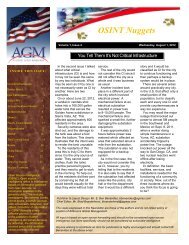Open Source Intelligence (OSINT) Link Directory - Allsource Global ...
Open Source Intelligence (OSINT) Link Directory - Allsource Global ...
Open Source Intelligence (OSINT) Link Directory - Allsource Global ...
Create successful ePaper yourself
Turn your PDF publications into a flip-book with our unique Google optimized e-Paper software.
Creative Commons Copyright © Ben Benavides—no commercial exploitation without contract<br />
Then there is human intelligence, or "humint," which has been around since the dawn of spycraft and is<br />
still vital. That's the tipster you cultivate and pay, or perhaps the unproven one who simply walks into a<br />
U.S. embassy and offers information.<br />
"Sigint," or signals intelligence, monitors or otherwise exploits radio, telephone or satellite phone<br />
transmissions. "Imint" is imagery intelligence that includes photographs showing the outlines of a nuclear<br />
power plant, obscured in desert sands, or a terrorist training base tucked in a mountainside.<br />
Cybertracking is a newer tool, pursuing terrorists who use computers either to attack a computer network<br />
or, more often, to organize how their own human network would launch a physical attack.<br />
___<br />
Q: What happens to this mountain of raw material?<br />
A: Each of those streams of data is captured by a multibillion-dollar worldwide network of U.S. satellites,<br />
armed drones, static blimps and high-flying spy aircraft, manned or unmanned, that suck up so much<br />
sound it takes massive computers to crunch all the data and help analysts overwhelmed by the technical<br />
information to find meaningful clues.<br />
Sometimes these streams are collected by U.S. operatives — Americans or those in U.S. employ — who<br />
go behind enemy lines or into enemy homes, leaving behind the sensors that will provide the data.<br />
True to its name, the Central <strong>Intelligence</strong> Agency is an "all-source" organization using all means.<br />
___<br />
Q: How do all these eyes and ears work together?<br />
A: Sometimes they don't. After a Nigerian allegedly tried to bring down a Detroit-bound airliner on<br />
Christmas Day almost two years ago, it emerged that his father had warned U.S. diplomats about his<br />
son's possible terrorist sympathies, but that tip was lost in the blizzard of counterintelligence.<br />
But in the bin Laden raid, a human source led to the compound in the Pakistani army town of Abbottabad.<br />
Signals intelligence monitored for phone calls emanating from there, and found none, because bin Laden<br />
forbade them, hoping to evade detection by just such technical means. Masint was derived from the<br />
imagery taken by drones and satellites.<br />
All of this helped to convince CIA analysts they had found their man and persuade President Barack<br />
Obama to approve a dangerous and diplomatically risky raid into Pakistani sovereign territory.<br />
___<br />
Q: How is all of this intel sorted through so that the real threats are detected and averted?<br />
A: The ever-present risk is that they won't be. One of the failings of pre-9/11 counterintelligence was that<br />
information was jealously guarded by the individual intelligence agencies. Word of a potential plot to fly<br />
planes into U.S. landmarks was received by one agency. Another agency had word terrorists might be<br />
attending flight school. Each organization kept to itself the dots of information that, when connected, could<br />
have revealed the larger pattern of a massive terrorist plot.<br />
Before raw data and human tips can be called "intelligence," they must be analyzed, and if possible,<br />
corroborated. The CIA alone has 2,500 people in its Directorate of <strong>Intelligence</strong> devoted to that task. There<br />
are thousands more across the 16 intelligence agencies, sifting raw data, and cross-comparing within<br />
their own agencies, and with others, to spot a pattern.<br />
14





